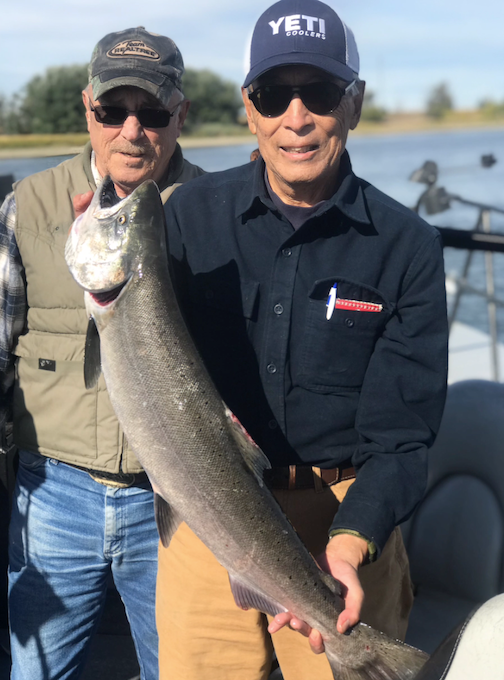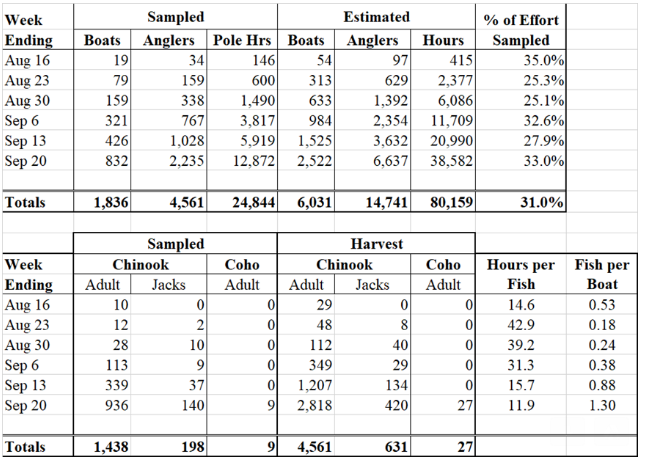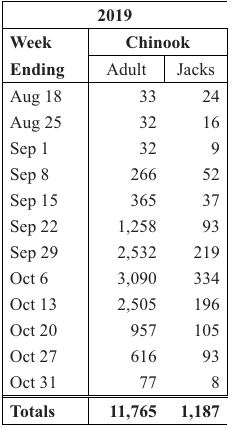
Hanford Reach Fishing Report (9-21-20)
THE FOLLOWING FISHING REPORT WAS FORWARDED BY PAUL HOFFARTH, WDFW
Fall Chinook fishing continues to be very good in the Hanford Reach. Boats averaged 1.3 salmon per boat, 12 hours per fish. There was a large proportion of hatchery chinook in this week’s harvest. Thank you to all the anglers for being patient while staff pulled snouts to recover the coded wire tag information.

WDFW staff interviewed anglers from 832 boats (2,235 anglers) and 154 bank anglers (Ringold Springs access) with a combined harvest of 936 adult chinook, 140 jacks, and 9 coho. Based on the sampling information, an estimated 2,818 adult chinook, 420 chinook jacks, and 27 coho were harvested from 6,637 angler trips.

For the season, there have been 14,741 angler trips harvesting 4,561 adult chinook and 631chinook jacks. In addition, 188 sockeye and 47 wild steelhead were caught and released.

Fall chinook counts at Bonneville are declining but McNary numbers are holding steady at 5,000 – 6,000 per day. The first in-season return for the Hanford Reach fall chinook population was completed last week. Current estimate is 74,455 natural (wild) fall chinook, up 14% from the pre-season forecast of 65,359 adults. In addition, both Priest Rapids and Ringold Springs Hatcheries are expecting good returns.
This week’s Technical Advisory Committee updates for the Columbia River should be available later today or tomorrow.
TAC met on Monday, September 14 to review and discuss salmon and steelhead passage at Bonneville Dam and harvest in fall season fisheries. TAC updated the expected Columbia River mouth abundances of URB, PUB, and BPH stock fall Chinook to 267,300, 80,100, 51,100 adults, respectively (total of 398,500 upriver fish). Given the preseason forecasts for lower river stocks, the total fall Chinook return is now expected to include 476,680 adults (13% greater than the preseason forecast). Passage of bright and tule components are both tracking several days earlier than recent-year averages.


TAC updated the in-season projection for A-Index and B-Index steelhead passage at Bonneville Dam. Given current information, TAC now expects 81,300 total A-Index fish (including 34,400 unclipped) which is 95% of preseason forecast and 28,800 B-Index fish (6,100 unclipped) which is 300% of forecast. The A-Index projections were based on the recent 10-year average run timing while the B-Index passage projections assumed their timing is five days earlier than the recent 10- year average. The aggregate A-/B-Index abundance is expected to total 110,100 fish.
TAC updated the projected return of early-stock coho (defined as those passing prior to September 30) to a minimum of 66,700 adults. The pre-season total coho forecasted return to Bonneville Dam was 42,300 fish (33,880 early stock and 9,400 late stock coho). TAC will continue to meet weekly throughout the fall management period and will provide further updates as information becomes available.

The Hanford Reach fall salmon fishery opened August 16 (Hwy 395 Bridge upstream to Priest Rapids Dam). Pre-season forecast for fall chinook to the Hanford Reach is 92,000 adults, 65,000 wild and 27,000 hatchery. Returns are expected to be very similar to last year. Daily limit is 6 salmon but anglers are limited to two adults. Anglers must stop fishing when the adult limit is retained. Anglers can harvest fall chinook and coho, both hatchery and wild. Anglers can use barbed or barbless hooks when fishing or salmon in this area of the Columbia River. Anglers may fish with two poles for any species except sturgeon with two-pole endorsement. Party fishing is not allowed when fishing for salmon in this section of the Columbia River. The Columbia River upstream of the Highway 395 Bridge is closed to fishing for steelhead.

The Yakima River is not expected to open for salmon this fall due to low projected returns for both fall chinook and coho. WDFW staff will monitor the return and could potentially open the fishery if numbers exceed current escapement goals.
